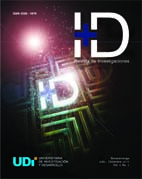Repeatability study by standard deviation of a Shack – Hartmann type aberrometer
DOI:
https://doi.org/10.33304/revinv.v06n2-2015004Keywords:
Repeatability, Aberrometer, Zernike polynomials, Adaptive opticsAbstract
The usual configuration for a system that measures ocular aberrations uses an infrared beam, which is focused on the retina, in order to act as a secondary source of radiation. The back reflected light from the retina emerges through the eye's optical system modulated with the total aberrations. This aberrated wavefront is measured with a Shack-Hartmann type sensor. An ocular aberrometer, could be connected, in a closed loop, with a deformable mirror in order to assemble an experimental setup of adaptive optics (AO). It is useful in ophthalmic instruments because improves the lateral resolution. In this work, the analysis of repeatability of the measurements for an experimental setup that allows measuring the aberrations of an in-vivo human eye is shown. This system will be used as part of an adaptive optics system for a fundus camera.Downloads
References
Balderas Mata S. E., Jones S. M., Zawadski R. J. & Werner J. S. (2011). Application of a new hispeed magnetic deformable mirror for in-vivo retinal imaging. Proceedings of 22nd Congres of the International Commission for Optics, 8 0 1 1 , 8 0 1 1 9 5 - 1 - 8 0 1 1 9 5 - 8 Doi:10.1117/12.903365
Cheng X., Himebaugh N., Kollbaum P., Thibos L. & Bradley A. (2003). Validation of a Clinical Shack-Hartmann Aberrometer. Optometry and Vision Science, 80,587-595. Doi:10.1097/00006324-200308000-00013
Fedtke C., Ehrmann K., Falk D. & Holden B. (2012). Validation of a quasi real-time global aberrometer: The eyemapper. Proceedings of SPIE Photonics West 2012, 8209,82090C-1- 82090C-7. Doi:10.1117/12.906927
Liang J., Grimm B., Goelz S. & Bille J.F. (1994). Objective measurement of wave aberrations of the human eye with the use of a Hartmann-Shack wave-front sensor. Journal of Optical Society of America, 11, 1949-1957. Doi:10.1364/JOSAA.11.001949
Thibos L. & Hong X. (1999). Clinical Applications of the Shack-Hartmann Aberrometer. Optometry and Vision Science, 76,817-825.












